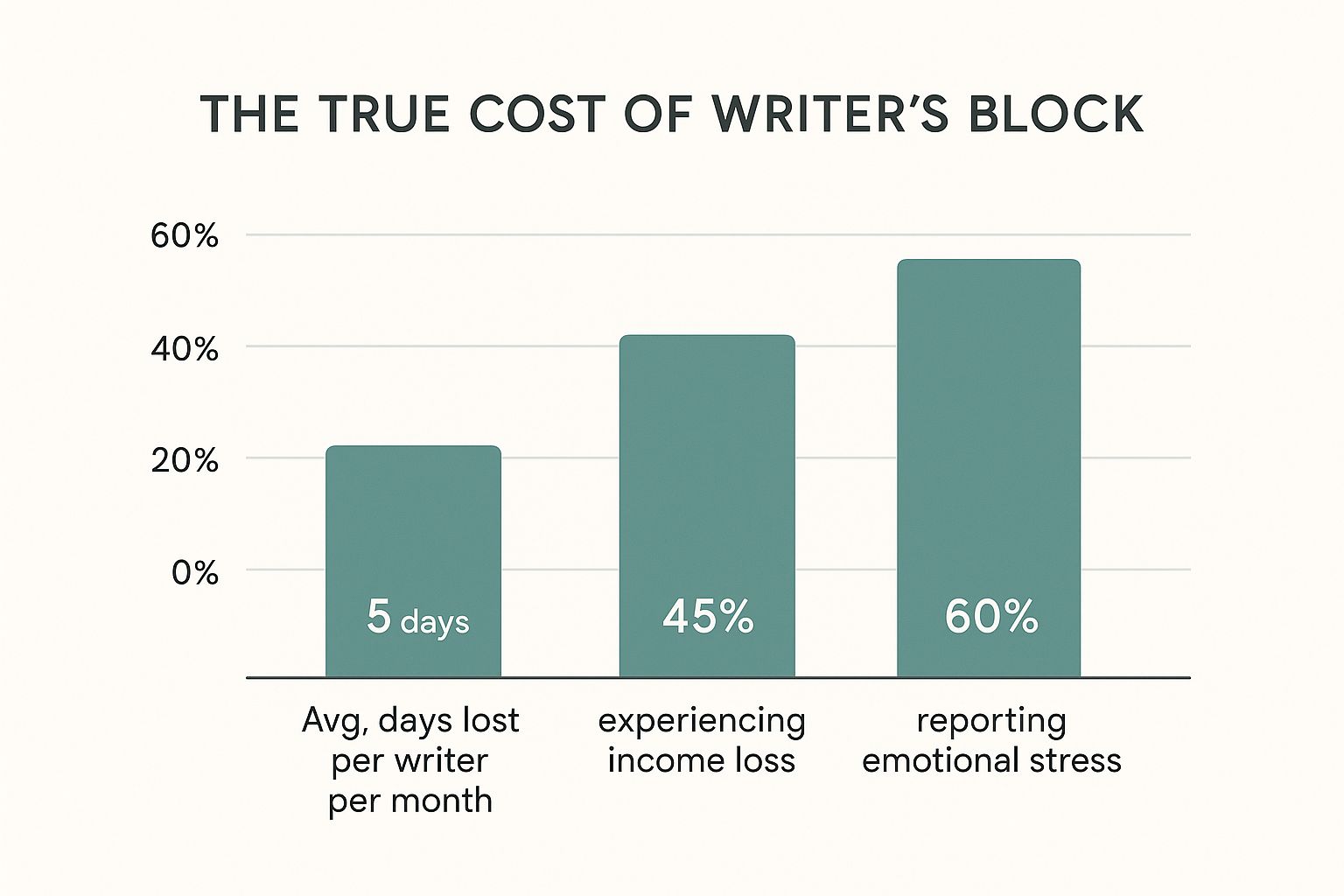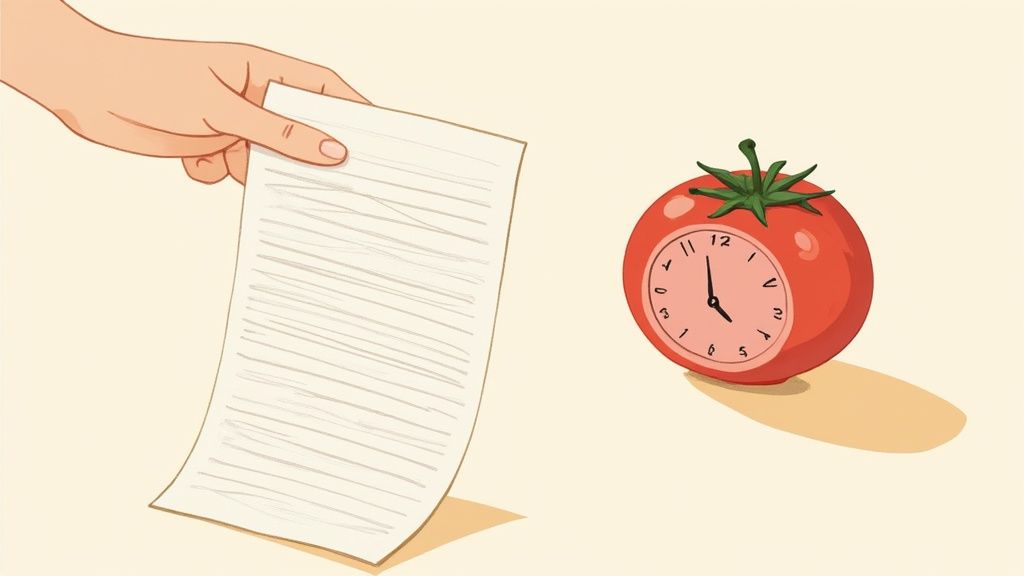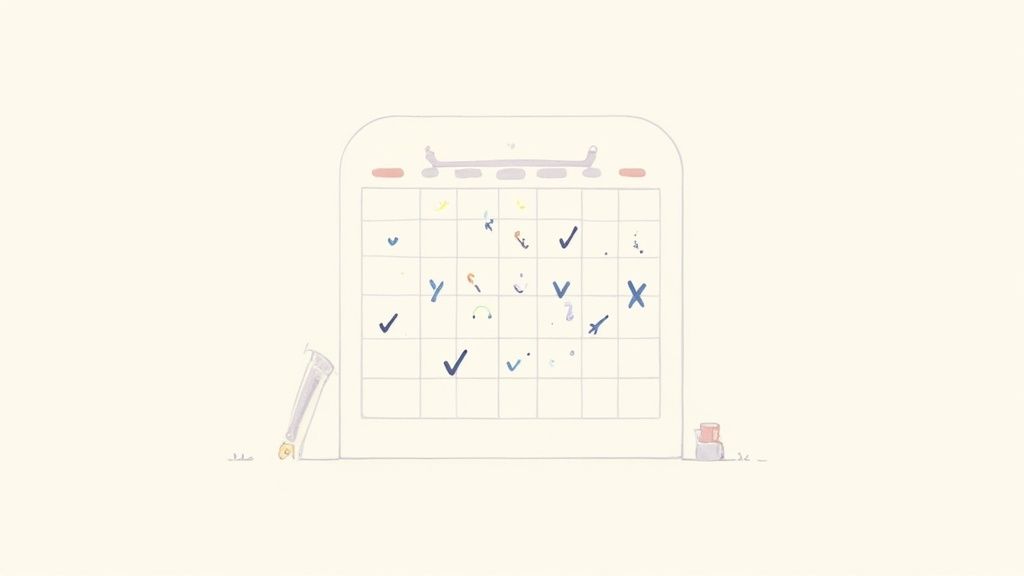How to Overcome Writer's Block and Start Writing
Stuck on a blank page? Learn how to overcome writer's block with practical, low-pressure strategies that reignite creativity and build sustainable habits.

We’ve all been there. That blinking cursor on a blank page starts to feel less like an invitation and more like a judgment. The pressure builds, and suddenly, the words just won't come.
It's tempting to think you can just power through it, but overcoming writer's block is rarely about brute force. Often, the best way out is through small, low-pressure actions that cost nothing: take a short break, write about something completely different, or just change your scenery. The goal is to break the cycle of anxiety, not stare down the daunting blank page until it submits.
Why You're Staring at a Blank Page
Writer's block isn't just a creative slump; it’s a genuine barrier with real-world costs. It stalls projects, puts deadlines at risk, and can slowly chip away at the very passion that made you want to write in the first place.
It's easy to internalize this struggle, to see it as a personal failure instead of what it truly is: a common, and completely solvable, problem.
Instead of blaming yourself, let's reframe the challenge. This isn't about a lack of talent or discipline. More often than not, it's a symptom of something deeper running in the background.
- Emotional Toll: The constant pressure to perform can crank up your stress and anxiety, making it even harder to tap into your creative flow.
- Financial Strain: For professional writers, time is literally money. Every day lost to the block is a day of lost income, creating a vicious cycle where financial worry just fuels the creative jam.
- Passion Fatigue: When writing shifts from a source of joy to a source of frustration, it can start to feel like a chore. That’s a dangerous place to be.
The Real Impact of Getting Stuck
This frustration is more than just a bad feeling. It has measurable consequences that hit your well-being and your professional stability. It's a widespread issue with serious psychological and economic ripple effects.
Research actually shows a deep connection between writer's block and affective disorders, meaning the emotional burden is just as significant as the financial one. In an industry like U.S. publishing, which generated over $26 billion in revenue in a single year, stalled creativity is a direct threat to the livelihoods of tens of thousands of writers. You can read the full research on its impact if you want to dive deeper.
"Writer's block is rarely just about the writing. If our mental or physical health is under pressure, it’s no wonder that coming to the page might feel complex or, under certain circumstances, impossible."
The infographic below paints a clear picture of what this really costs, showing how lost days, income, and emotional health are all tangled together.

What really stands out is that the emotional stress, reported by 60% of writers, is a massive part of the problem—often more impactful than the direct financial hit. Understanding these costs is the first step toward finding real, affordable solutions that actually work.
Diagnosing the Cause of Your Writer's Block
Before you can beat writer's block, you have to figure out what’s actually causing it. That blinking cursor on a blank page? It isn’t the real enemy. It’s just a symptom of a deeper issue. Treating every block the same is like trying to fix everything with a hammer—sometimes you really need a screwdriver.

More often than not, what feels like a creative problem is actually a psychological one. Things like fear of failure, crippling perfectionism, or good old impostor syndrome can freeze your thoughts long before they ever get near a keyboard. It’s a crisis of confidence, not a shortage of ideas.
But sometimes, the block is purely tactical. Maybe you’re trying to build a house without a blueprint, working without a clear outline. Or maybe you're just plain exhausted. Naming the real source of the friction is the first real step you can take.
Pinpointing the Root Cause
Let’s get specific. Your writer's block is rarely just about writing. Think of yourself as a detective, and your creative process is the crime scene. It’s time to ask some honest questions to narrow down the suspects.
Start here:
- How do I feel when I sit down to write? Anxious? Tired? Bored? Overwhelmed?
- What am I really afraid will happen if this piece is "bad"? Am I worried about judgment from others? Convinced I'm wasting my time?
- Do I even know what I’m trying to achieve here? Is the goal crystal clear, or am I just fumbling in the dark?
- When was the last time I took a real break? Not just switching tasks, but genuinely unplugging?
Your answers are clues. If you’re terrified of judgment, you’re dealing with a psychological hurdle. If you’re just exhausted and uninspired, you might just be burnt out.
Writer's block is often a symptom of something else going on in your life. Step away, accept that your mind needs rest, and work out what else is bothering you. Joy in writing returns when the storm passes.
Psychological Hurdles vs. Tactical Missteps
It’s critical to know whether you’re facing an internal mindset issue or an external process problem. One requires self-compassion and some mental reframing; the other demands a practical tweak to your workflow.
This distinction is everything because it helps you choose the right tool for the job. You can’t outline your way out of burnout, and a freewriting exercise won’t solve a deep-seated fear of failure on its own.
Understanding Your Creative Struggle
To help you figure out what’s really going on, I’ve put together a quick breakdown of the common triggers. Think of this as a diagnostic chart for your writer’s block. See where your symptoms align to find the root cause.
| Type of Block | Common Symptoms | Potential Cause |
|---|---|---|
| Psychological | Feeling like a fraud, deleting every sentence, avoiding the task entirely. | Fear of imperfection, impostor syndrome, or pressure from past successes. |
| Tactical | Unsure where to start or what comes next, feeling bored with the topic. | Lack of a clear plan, insufficient research, or a mismatch in project interest. |
| Burnout | Physical and mental exhaustion, lack of enthusiasm for any writing. | Overworking without breaks, chronic stress, or too many competing deadlines. |
| Perfectionism | Getting stuck on a single word or sentence for hours, endless rewriting. | Unrealistic standards, believing the first draft must be flawless. |
Once you pinpoint the category your block falls into, you can stop fighting the symptoms and start treating the actual problem. This is how you find the most effective—and affordable—path to getting unstuck for good.
Low-Pressure Techniques to Get Words on the Page
Sometimes, the best way to beat writer’s block is to just stop trying so hard. That internal pressure to write the perfect sentence can be completely paralyzing. The goal here isn't perfection; it's simply to get words on the page—any words at all—to break that inertia and start building some momentum.

This isn’t about writing your final draft. It’s about tricking that inner critic into taking a coffee break. Think of it like stretching before a workout. These are low-stakes exercises designed to warm up your writing muscles without the fear of failure, making it so much easier to slide back into your main project.
The key is progress, not perfection. Let’s walk through a few practical, stress-free methods that cost you nothing but a little time.
Embrace Freewriting for Unfiltered Thoughts
Freewriting is exactly what it sounds like: writing continuously for a set period without caring about spelling, grammar, or even if you're staying on topic. You just let your thoughts spill onto the page, no judgment allowed. This technique is fantastic for bypassing that analytical part of your brain that’s often causing the block in the first place.
Here’s a simple exercise to try:
- Set a timer for just 10 minutes.
- Start with a simple prompt, like "The view from my window is..." or "What I really want to say is..."
- Write without stopping. Seriously. If you run out of things to say, just type "I don't know what to write" over and over again until a new thought pops into your head.
The only rule is to keep your fingers moving. You'll be surprised by the ideas that bubble up when you remove the pressure to be brilliant. It’s a powerful and affordable way to reconnect with your natural voice. And if you need a little help getting those first few words down, our free hook generator can give you some starting lines to play with.
Use the Pomodoro Technique for Focused Bursts
The idea of writing for hours can feel totally overwhelming. But what about just 25 minutes? Anyone can do that. The Pomodoro Technique is a time management method that breaks your work into short, focused sprints separated by brief breaks.
This approach makes the entire task feel way more manageable. Knowing a break is just around the corner helps lower the anxiety and lets you concentrate fully on the immediate goal: getting some words down on the page.
Don't stare at the entire staircase; just focus on the first step. The Pomodoro Technique is about taking that one small step, over and over again, until you reach the top without even realizing it.
Change Your Writing Environment
Sometimes the block isn't in your head; it's in the room around you. Your brain can form a negative association with your usual writing spot, linking it to feelings of frustration and stress. A simple change of scenery can be all it takes to reset your creative mindset.
You don’t need an expensive retreat. Just try one of these free options:
- Move to another room: If you always write at your desk, try the kitchen table or a comfy chair in the living room.
- Visit a local library: The quiet, studious atmosphere can be incredibly motivating.
- Go to a coffee shop: For some writers, the ambient noise and energy of a bustling café is the perfect backdrop for focus.
- Write outside: A park bench or your own backyard can provide fresh air and a fresh perspective.
This small shift is often enough to disrupt the routine that's keeping you stuck. I once spent an entire week battling a single paragraph at my desk. On a whim, I took my laptop to a nearby park and ended up finishing the whole chapter in two hours. That change of scenery was all I needed.
Building a Resilient Writing Mindset
Getting unstuck is a great feeling. But the real win? Staying unstuck.
This isn't about finding a magic trick for your next block. It’s about building a resilient writing mindset—your best defense against future creative stalls. The goal is to fundamentally shift your relationship with the act of writing itself.
A huge part of this is learning to quiet your inner editor, especially when you're just getting started on a project. That nagging voice questioning every word choice is often the very thing causing the paralysis in the first place. You have to give yourself permission to write a truly messy first draft.
A first draft is just you telling yourself the story. It doesn't have to be perfect; it just has to exist. Detaching your self-worth from your daily word count is a crucial part of this process.
When you embrace imperfection, you reframe writing from a high-stakes performance into a low-pressure exploration. That simple mental shift makes it so much easier to show up to the page, day after day.
Normalizing the Struggle
It’s easy to feel like you're the only one staring at a blinking cursor. But the truth is, "creative inhibition" is a well-documented phenomenon that writers have wrestled with for centuries.
Historical accounts show that while the term got popular in the 19th century, legendary authors have always battled their own creative demons.
And it’s not just “in your head.” Neurological studies show that, in some cases, writer’s block can be linked to physical conditions like agraphia or writer’s cramp—both of which involve complex brain mechanisms. This confirms that the struggle is a real, multifaceted issue, not some personal failing. You can discover more insights about these historical findings on PMC.
Understanding that this is a normal part of the creative cycle demystifies the experience and strips it of its power.
Adopting a More Compassionate View
Building resilience always starts with being kinder to yourself. Instead of beating yourself up over a "bad" writing day, try treating yourself with the same compassion you'd offer a friend.
Here are a few mindset shifts you can practice:
- Focus on the process, not the outcome. Celebrate the act of showing up and putting in the time, regardless of how many words you produce.
- Separate your identity from your writing. You are not your work. A difficult project doesn’t make you a bad writer.
- View blocks as signals. A block isn't a wall; it's a sign that you might need to rest, do more research, or just tackle the problem from a new angle.
These small, consistent adjustments add up, creating a more sustainable and enjoyable writing life. For more tips on maintaining a healthy creative routine, check out our guide on the Contentide blog.
Ultimately, this compassionate approach is your best long-term, ethical strategy to beat writer’s block for good.
Creating a Writing Routine You Can Actually Stick To

Let's be honest: waiting for "inspiration" to strike is a losing game. The single most effective weapon against writer’s block isn't a muse; it’s a routine.
Building a routine isn’t about finding massive, four-hour blocks of uninterrupted time. For most of us, that’s a fantasy. It’s about creating small, sustainable habits that fit into the messy reality of your actual life. This is how you reclaim control.
The goal here is to make writing easier than not writing. Forget the romanticized image of the tortured artist. A simple, repeatable routine means you're already at your desk, ready to go, when an idea finally shows up.
This is where you build the muscle memory for your craft. It’s about proving to yourself, through small, repeated actions, that you are a writer who writes.
Setting Small, Almost Ridiculous Goals
The pressure to write a masterpiece right out of the gate is paralyzing. It’s the fastest way to get blocked. So, we need to shrink the goal until it feels almost laughably easy.
Instead of trying to nail an entire chapter, aim for a single paragraph. Or just 100 words. If even that feels like too much, make the goal to simply open the document and write one sentence. That's it.
This little trick shifts your focus from the overwhelming final product to a tiny, immediate action you can actually complete. Finishing these micro-goals gives you a steady drip of small wins, building the momentum and confidence that slowly pushes the block away.
The most productive writing life is built on a foundation of small, consistent habits, not on rare bursts of intense effort. It’s about showing up, even for just 15 minutes.
Finding Those Hidden Pockets of Time
You don't need a huge window of time to make real progress. Most of us are juggling jobs, family, or school. The real secret is to identify the small, often wasted pockets of time that already exist in your day.
Could you write during your lunch break? For 20 minutes before anyone else in the house wakes up? While you're waiting in the car for your kid's practice to end? These brief, affordable sessions add up faster than you think.
The key is to treat these short sprints with the same seriousness as a longer session. A focused 15 minutes of writing is infinitely more productive than an hour spent staring at a blank screen, completely overwhelmed.
Creating Your Weekly Writing Blueprint
A vague goal like "write more" is useless. A plan, on the other hand, turns that intention into concrete action. Mapping out your week removes the daily guesswork of when and where you’ll write, which is often half the battle.
This doesn't need to be some rigid, color-coded spreadsheet that controls your life. A simple structure is all you need to create the accountability that keeps you on track.
To help you get started, I’ve put together a simple template. Adapt it to your own schedule, whether you’re a busy parent, a student, or a professional with a demanding job. The focus is on what actually works in the real world.
Your Weekly Writing Routine Builder
Use this template to schedule consistent, manageable writing sessions into your week.
| Day | Time Slot | Writing Goal (e.g., 200 words, 15 minutes) | Location/Environment |
|---|---|---|---|
| Monday | 7:00 AM - 7:20 AM | 20 minutes of freewriting | Kitchen table with coffee |
| Tuesday | 12:30 PM - 12:50 PM | Outline one blog section | Desk at the office |
| Wednesday | 9:00 PM - 9:30 PM | Write 150 words on main project | Quiet room, no phone |
| Thursday | Rest Day | No writing scheduled | Focus on recharging |
| Friday | 6:30 AM - 7:00 AM | Edit Wednesday's work | Favorite armchair |
This isn't about perfection; it's about persistence. Having a simple, visible plan like this is a powerful tool to beat writer’s block and keep your words flowing consistently.
Frequently Asked Questions About Writer's Block
Even with a solid game plan, you're bound to run into specific roadblocks. It happens to everyone. Here are some quick, no-nonsense answers to the questions that come up most often when you’re wrestling with a stubborn blank page.
What Should I Do When a Great Idea Vanishes Mid-Project?
This one is beyond frustrating. You have a concept you know is brilliant, but then... nothing. It just fizzles out. The absolute worst thing you can do is try to force it.
Instead, give the idea some breathing room. Step away for a day or two. Work on something else entirely—something low-stakes, maybe even fun.
The idea isn't gone for good; your brain is just stuck going down the same dead-end path. When you shift your focus, you let your subconscious do its thing and find a new way in. Come back to it with fresh eyes. Maybe try re-outlining just the next few paragraphs instead of staring at the whole intimidating project.
Is It Writer's Block or Am I Just Burned Out?
Knowing the difference here is critical. One requires a creative strategy; the other requires genuine rest.
Writer's block is usually project-specific. It’s tied to creative anxiety or a specific problem you can't solve, like a plot hole. Burnout, on the other hand, is a deep emotional and physical exhaustion that makes everything feel like climbing a mountain, not just your writing.
- Writer's Block: You’re stuck on your manuscript but could probably go for a run or meet up with friends.
- Burnout: You feel a heavy, all-encompassing exhaustion. Motivation is gone, not just for writing, but for most things in your life.
If you’re burned out, no amount of freewriting exercises will fix it. The only solution is to step away and truly unplug.
Are AI Writing Tools an Ethical Solution?
AI tools can be a decent crutch, but they are absolutely not a cure.
Using an AI to brainstorm a few outlines or rephrase a clunky sentence? That can be a great way to get some momentum back. Think of it as a temporary assistant, not the author. It is an affordable way to get unstuck.
But relying on AI to generate your core ideas or write entire drafts for you is a different story. It's ethically murky and, more importantly, it robs you of the chance to develop your own unique voice.
We tackle more questions like this in our complete FAQ section.
The best and most ethical solution to writer's block will always be found in your own mind—through rest, new habits, and a bit of self-compassion. Tools can help, but they can't replace the human heart of storytelling.
This isn't just a niche problem, either. It’s everywhere. Recent studies show that at least 10% of college students regularly battle writer's block, which takes a toll on their grades and well-being. The demand for workshops on this topic is exploding for a reason. If you're curious, you can discover insights about its prevalence in academic settings in this study.
Feeling stuck on your professional content? Contentide is an AI-powered content generator designed to turn your rough ideas into polished, high-performing LinkedIn posts in minutes. It helps you stay consistent and grow your network without the stress of the blank page. Get started for free today and see how easy it can be to publish authentic content that connects with your audience. https://contentide.com
Hope you found this helpful. Feel free to share your thoughts.